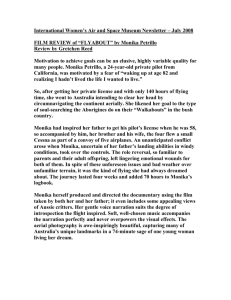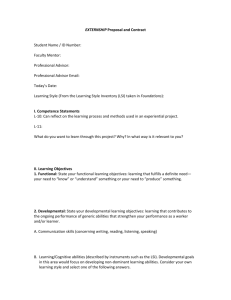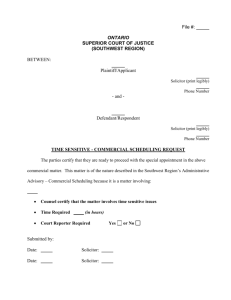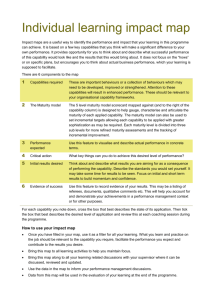communicating with children over 10
advertisement
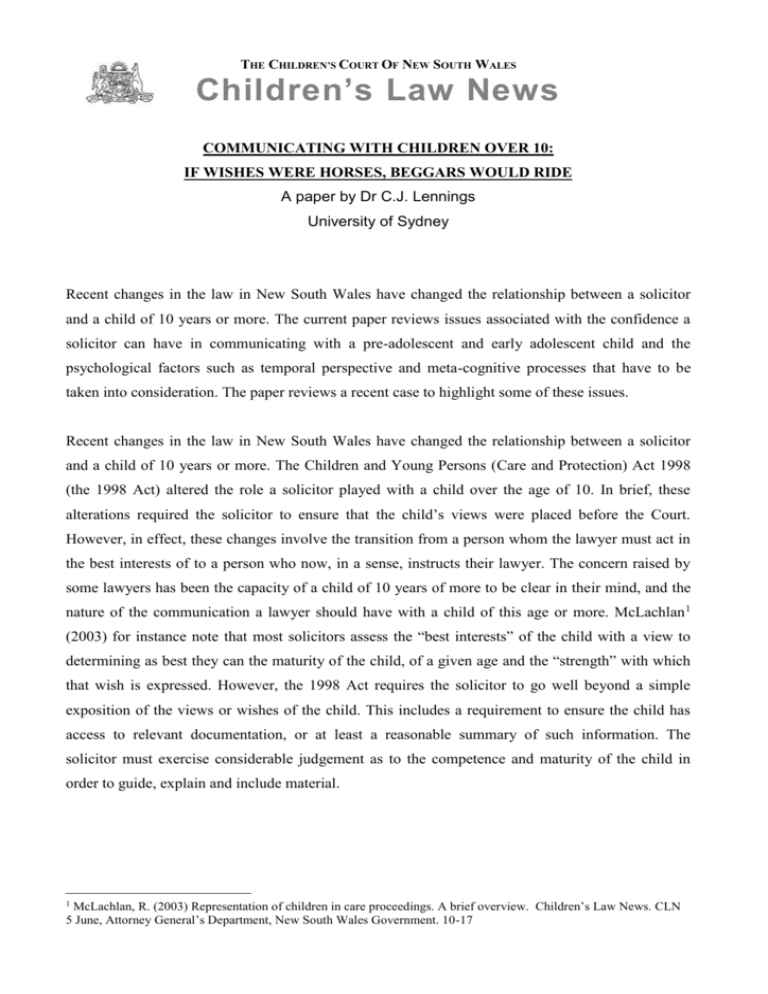
THE CHILDREN’S COURT OF NEW SOUTH WALES Children’s Law News COMMUNICATING WITH CHILDREN OVER 10: IF WISHES WERE HORSES, BEGGARS WOULD RIDE A paper by Dr C.J. Lennings University of Sydney Recent changes in the law in New South Wales have changed the relationship between a solicitor and a child of 10 years or more. The current paper reviews issues associated with the confidence a solicitor can have in communicating with a pre-adolescent and early adolescent child and the psychological factors such as temporal perspective and meta-cognitive processes that have to be taken into consideration. The paper reviews a recent case to highlight some of these issues. Recent changes in the law in New South Wales have changed the relationship between a solicitor and a child of 10 years or more. The Children and Young Persons (Care and Protection) Act 1998 (the 1998 Act) altered the role a solicitor played with a child over the age of 10. In brief, these alterations required the solicitor to ensure that the child’s views were placed before the Court. However, in effect, these changes involve the transition from a person whom the lawyer must act in the best interests of to a person who now, in a sense, instructs their lawyer. The concern raised by some lawyers has been the capacity of a child of 10 years of more to be clear in their mind, and the nature of the communication a lawyer should have with a child of this age or more. McLachlan 1 (2003) for instance note that most solicitors assess the “best interests” of the child with a view to determining as best they can the maturity of the child, of a given age and the “strength” with which that wish is expressed. However, the 1998 Act requires the solicitor to go well beyond a simple exposition of the views or wishes of the child. This includes a requirement to ensure the child has access to relevant documentation, or at least a reasonable summary of such information. The solicitor must exercise considerable judgement as to the competence and maturity of the child in order to guide, explain and include material. McLachlan, R. (2003) Representation of children in care proceedings. A brief overview. Children’s Law News. CLN 5 June, Attorney General’s Department, New South Wales Government. 10-17 1 The 1998 Act codifies the role of the child to participate in the proceedings in a more active way than the prior Act has done. Barnatt & Wilson2 (2004) have identified that following on from the United Nations Convention on the rights of the Child the “liberal” philosophies have been to increase the participation of children in decision making about things that effect their own lives. (See also Mason3 (2002) for a discussion and defence of the need to include children’s views in custody evaluations). Barnatt & Wilson (2004) outline some of the issues involved in such activities, including potential for traumatising children in seeking wishes, and the delicate balance that has to be struck between “protecting children” and including children in how to ascertain the best interests of the child. Similar points are made by McLachlan (2003) in his discussion of the 1998 Act. This paper considers some of the issues involved in responding and working with children, with special reference to the forensic interviewing of children (here defined as children under 12) and early adolescents (defined here as aged 12 to age 15). The paper takes as its starting point a need to identify some objective criteria for determining the maturity of a child. The Heterogeneity of Children. Kuehnle, Greenberg & Gottlieb4 (2004) discuss the expectations and difficulties for interviewing children of various ages, identifying that after the age of about 5 years children begin to develop the kinds of cognitive skills that allow them to be interviewed with some reliability. In their view it is not until somewhere between the age of 9 and 12 does the child develop a sufficient awareness of family dynamics to be able to answer questions in regard to custody decisions. Ackerman, Ackerman, Steffen & Kelly-Poulos5 (2004) conducted a survey of judges, lawyers and psychologists working in the child-protection field. Their survey revealed that the averaged mean age at which a child should be able to make a binding decision about who to live with (custody or residence) for all three professional groups was 15.17 years. In contrast the averaged mean for decisions about visits (access/contact) was later, at 15.95 years. These ages obviously imply a very conservative notion of the maturity of a child, and the extent to which a child’s wishes should be followed. Barnett, C., & J. Clare Wilson (2004) Children’s “Wishes” in the Australia Family court: Are they wishful thinking? Psychology, Psychiatry and the Law, 11 (1) 73-78. 3 Mason, M. A. (2002) The custody wars: Why children are losing the legal battle and what we can do about it. New York: Basic Books. 4 Kuehnle, K., Greenberg, L. R., & Gottlieb, M. C. (004) Incorporating the principles of scientifically based child interviews into Family Law Cases. Journal of Child Custody: Research, Issues and Practice. 1, 97-114. 5 Ackerman, M. J., Ackerman, M. C., Steffen, L. J., & Kelly-Poulos, S. (2004) Psychologists’ practices compared to the expectations of family law judges and attorneys in child custody cases. . Journal of Child Custody: Research, Issues and Practice. 1, 41-60 2 CHILDREN’S LAW NEWS – 2004 2 From a developmental perspective 10 years of age is not a natural “cut-off” point in childhood. Utilising Piaget’s notion of developmental stages6, 10 falls midway in to the “Concrete Operations” phase of development (which gives way to formal operations around the age of 12). Within the notion of psychosocial development, 10 falls towards the upper end of Erikson’s7 “fourth period” referred to as industry versus inferiority which is supposed to more or extend from 6 years of age to about 12 years of age. Adolescence can variously be said to begin at 11, 12 or 13 and to end at age 19 8, although some authors suggest that true adult status is not achieved until the mid-20’s (Levinsohn9, 1989). Depending on the issue being examined, developmental trends suggest that a period of confusion exists when adolescents may, or may not, develop skills akin to those of adults in understanding and accounting for their own behaviour (Steinberg & Cauffman10, 1999) . This period of confusion generally occurs between the age of 13 and 17. During this period developmental trends are such that by the age of 17 we can confidently expect that a juvenile should be able to understand, and have the appropriate cognitive and emotional development to account for his or her behaviour and be responsible for it. Before 13 years of age, they suggest we can be confident they do not have such abilities. That is, prior to the age of 13 juveniles demonstrate reasoning, emotional and social competencies more like children than like adults. Factors, which impact on the ability of adolescents to explain their own behaviour, include: the extent to which we can impute meta-cognitive abilities (that is, the ability of a person to have awareness of their thinking processes. Sometimes we can recognise this when we talk to ourselves, coaching ourselves in what we should do, or should have done), the extent to which adolescents of this age may be affected by emotional and psychological pressures about which they lack insight, (that is, the hormone problem), the tension between the developmental tasks of establishing identity and autonomy from the family in the context of continued dependency on the family and other social institutions Differences in maturation rates between adolescents that can produce significant developmental pressures. For example the early development of breast in young girls, or 6 Piaget, J. & Inhelder, B. (1968) The Psychology of the child. Basic Books: New York Erikson, E. (1960) Childhood and society. New York: W. W. Norton. 8 World Health Organisation, http://www.who.int/child-adolescent-health/OVERVIEW/AHD/adh_over.htm 9 Levinson, D. J. 1986. A conception of adult development. American Psychologist. 41, 3-13. 10 Steinberg, L., & Cauffman, E. (1999) A developmental perspective on serious juvenile crime: When should juveniles be treated as adults? Federal Probation, 63(2), 52-57. 7 CHILDREN’S LAW NEWS – 2004 3 the failure to grow in young men may produce crises in self-esteem, and a sense of difference. Table 1 identifies some of the key differences between these latency aged and early adolescent children. Two of the most important differences between these groups lie in the development of time perspective, and meta cognitive process. _____________________ Insert Table 1 _____________________ Time perspective in adolescence is characterised by the realisation of the past and future and the capacity to link these states with the present11. One of the tasks of adolescence is to achieve a sense of time perspective or a continuum along which actions can be judged and anticipated. Before adolescence children may talk about “when I grow up” or some kind of future state, but cannot link that with lived experience. The concept of the future tends to be empty, or when populated, with unrealistic events. Thus obtaining instructions from a 10 year old that require the child to consider the consequences of their decisions even a few years into the future is quite simply guess work. Meta-cognitive thought refers to the capacity a child has to be aware of their own thought processes (Steinberg & Cauffman, 1999). Prior to this development children have very limited access to their own thoughts and feelings and can make judgements about things that are divorced from their feelings- they are more likely to be influenced by recent events, external “facts” and ignore their own feelings and thoughts on the matter – they are not likely to be able to differentiate what they think and feel from what others think and feel. In obtaining instructions, meta-cognitive skills can be related to “source monitoring”, Powell & Thomson12 (2003). In conventional studies of childhood witness memories, source monitoring refers to the identification of memories that might have come from witnessing an event or from insertions of details through discussion of the event with significant others. Typically, children have difficulties allocating the source of memories, and hence run the risk of confusing introduced detail with actual recollections. Source monitoring is an example of meta-cognitive skill or awareness of Lennings, C. J.; Burns, A. M., Cooney, G. Profiles of time perspective and personality: Developmental considerations. (1998) Journal of Psychology.132, 629-643. 12 Powell, J., & Thomson, D. (2003) The making of a reliable interview with a child witness. Australian Educational and Developmental Psychologist. 11 CHILDREN’S LAW NEWS – 2004 4 the nature of one’s thoughts or memories. Factors that effect meta-cognitive thought include verbal competence or “self-talk”, experience, and maturity. A problem for the solicitor seeking to take instructions from an older child or young adolescent occurs if the child is going to be treated as if he can give instructions, but in reality cannot discern the source of their experiences and distinguish between their own, and others, wishes. Paradoxically, the opportunity for influence on such a child is therefore much greater. For instance, in one family I work with from time to time the child is approaching 10 and the mother, quite savvy to things legal, has told me that when he is 10 she is going to tell him (her son) what instructions to give his solicitor, (some of which, I assume will be close to anatomically impossible). Similarly, a lack of meta-cognitive ability means that if a child gets angry or upset, they cannot begin a process of “talking themselves down” and allowing for an opportunity to consider other aspects of a situation. What Constitutes Maturity? The presumption is that children should participate in decisions that affect their life, dependent on their ability to do so (Mason, 2002). This presumption raises the issue of what does relevant maturity mean and how is it assessed? How do we know when a 10 or a 12 year old is a “mature”? How do we assess competence in a child, for that matter? A review of leading text books in developmental psychology was undertaken. None had any clear means of defining, let alone measuring, “maturity”. Most refer to the “normative” tasks of the adolescent, or the pre-adolescent but none venture a definition of the “mature” child. Similarly, neuropsychological text books and books on forensic assessment were equally silent. There is much about what constitutes legal competence for adults, but this is of little help in this topic, since almost by definition, a 10 year old fails many of those tests. At its most basic level competence refers to the ability to reason, and the understanding of the situation confronting the person. In considering the potential definitions of childhood competence, the Gillick13 case, decided in the House of Lords in 1985, provides some discussion. The Gillick case provides some options of what the House of Lords construe as competency in the case of when can a teenage girl make decisions about contraception. Whilst the Gillick case has only marginal relevance here, the issues raised by the judges boil down to two related notions: the capacity of the child to understand (in the full sense of the word) the import of the decisions they asked to take, and the nature of their intelligence. As an aside, the judges seems to be of the view 13 Gillick v West Norfolk and Wisbech Area Health Authority and another. All England Law Reports, 1985 3 All ER p, 402-437. CHILDREN’S LAW NEWS – 2004 5 that the combination of understanding and intelligence was probably rarely evidenced in children under 14 (in so far as being able to make decisions about sexual issues). Although no clear principles for adjudging when a child has achieved the requisite level of maturity were established, the case raises the spectrum of definitional issues such an analysis needs to consider. The judges implied view in this matter, that competence could rarely be seen under the age of 14 seems to have a transatlantic echo in the work of Ackermann et al. (2004). In that work judges and solicitors, on the whole, assessed competence to decide who to live with, or who to visit was not seen as occurring until about 15 years of age. Maturity and Competence. Borrowing from the literature on Fitness, the following could be said are the tasks of a mature person (Melton et al., 1997). These are “competencies” and, as such stand as operational definitions of what maturity might be considered to be in a child within the forensic environment. The ability to communicate a choice the ability to understand relevant information the ability to understand the nature of the situation and its likely consequences the ability to manipulate information rationally Competence has a dual nature (Charland, 2001)14. Firstly, competence judgements should be objective and the criteria for deciding when a child is able to make such judgements should be outlined, and agreed on by a majority of experts. Ideally, similar judgements should be reached in similar cases. However, competence is also normative, standards (and hence judgements) change, and judgments must be able to take into account flexibility, and in the case of children, it may be very difficult to set a legislative age at which competence is reached. The Gillick case appears to present an argument for establishing a normative standard, but any such standard will still require a set of criteria, such as the ones above, to consider competence against. The emphasis in the Gillick matter is on the capacity of the child to reveal a “wise” choice. Although “wise choice” is undefined, it implies understanding not only the current but also the future impacts of the behaviour under question, not only upon the self, but on others connected to the self. That is, it implies the capacity of intelligent appraisal, time perspective and perspective taking. Obviously 14 Charland, L. (2001) Mental competence and Value: The problem of normativity in the assessment of decision-making capacity. Psychiatry, Psychology & the Law, 8, 135-145. CHILDREN’S LAW NEWS – 2004 6 these factors have to be moulded to fit the developmental requirements of a child, but, and the issue is a big “but”, they cannot be moulded beyond a certain level. I would probably argue that these criteria, if accepted could not adequately be applied to most children, leaving some issue as to how reliable a child’s (as opposed to an early adolescent’s) wishes might be in complex or uncertain cases. In practice, most psychologists determine that a child is of adequate maturity for their age if they have an IQ that falls within the normal range – that is better than the bottom 32% of the population and if on a measure of adaptive functioning, such as the Vineland they also fall within the adequate range. Some thought should be given to children whose IQ profile shows large inter-scale discrepancies. In such cases, where the weakest tests are measures of verbal ability and communication, then it would be wise to ignore the overall IQ and to base the judgement on the verbal abilities thought to underlie communicative competence, and social understanding. However, social psychologists have for a long time identified that a great discrepancy can exist between a child’s understanding of every day reality and social reality, with social issues usually presenting the more demanding context in which to assess maturity. Any attempt to quantify “maturity” falls foul of the very complexity of what is meant by such a term. Ultimately maturity is inferred by the presence of both social reasoning skills, as well as ageappropriate cognitive development. Potential indicators to suggest that a child one is talking to is sufficiently like other 10 years olds, or any age under 16 years, then the following might be useful. 1. Absence of a birth history suggestive of developmental delay, history of head injury or epilepsy, or extensive hospitalisation for serious childhood illness 2. Evidence of good peer relationships. The older the child the more salient these peer relationships should be. Evidence is found in integration with friends through shared activities, social events, and spontaneous recollections of activities with peers. 3. Evidence of at least average school performance. This should include both academic domains (no placement in special schools, no intensive support teacher programs, passing tests) and behavioural, especially an absence of suspensions or expulsions. 4. No significant mental health history. 5. Children whose language form was as expected for their expected age group, and when there were no reasons to suspect they lacked familiarity with English. Use of baby language and immature vocalisations and expressions etc would indicate concern. 6. If seeing an adolescent over the age of 13 without evidence of the onset of puberty. CHILDREN’S LAW NEWS – 2004 7 Parentification. Maturity is not just a function of a child who “looks” like they are bright. For instance some children can develop physically but remain psychologically quite immature. However, social psychology tells us we often make assumptions of character and intelligence based on looks. Secondly, in the child protection area “parentification” especially of older children and female children occurs in abusive families. Thus children take on roles and demeanour that implies a greater level of understanding or ability than they truly have. However, “seeing is not believing” and each case needs to be assessed for the reality base of the roles and apparent maturity the child shows. Whilst children can be expected to range widely in individual abilities, judgement is required when it appears that a child is substituting for the neglect of a parent. In those cases, exercising caution in considering the maturity or capacity of a child to make a wise choice about their life is necessary. Obtaining an expert report to provide some kind of assistance in this matter might be helpful, but in the end it is the solicitor’s judgment that counts. The Interview. Some key considerations do evolve from the forensic literature on interviewing children that do, however appear sufficiently important to review. These are not reviewed in detail here, but reviews are available in Melton,15 Petrilla, Poythress, & Slobogin 1997 and the work of Martine Powell (Powell & Lancaster 16, 2003; Wilson & Powell, 1997)17. Important considerations include the requirements to see the child on a number of occasions, and to avoid as much as possible telephone interviews. A need remains to utilise appropriate interview styles, especially the open, narrative approach and to use Q&A approaches only following obtaining the most fulsome account they can give. Unintentional influence in interviewing through Yield and Shift techniques (such as repeating the question several times, implying approval or disapproval of answers) needs to be closely monitored by the solicitor and, if possible, removed from their interview patter. Finally, it is imperative the interviewer approach the interview with an objective frame of mind, as free as possible from what ever conclusions may be have been reached by the solicitor after reading the various affidavits in the file. 15 Melton, G. B., Petrila, J., Poythress, N. G., & Slobogin, C. (1997) Psychological evaluation for the courts. (2nd Edition). New York: Guilford Press. (See chapter 15). 16 Powell, M., & Lancaster, S. (2003) Guidelines for interviewing children during custody evaluations. Australian Psychologist, 38, 46-54. 17 Wilson, J. C., & Powell, M. (1998) Investigative interviews with children. Washington: American Psychological Association. CHILDREN’S LAW NEWS – 2004 8 Case Study To illustrate the key issue raised above, a brief case study is presented. (The child’s name and some other details have been changed to protect identity). Monika, an 11 year old girl is the second oldest of 4 girls. Her 14 year old step-sister lives with the others and the mother, but is largely “doing her own thing”. The father lives separately. A Family Court report has been called for. Monika states she wants to stay with her mother. The report recommends against placing strong weight on her wishes, because, in effect, I say Monika does not mean what she says. The report argues that Monika has been “coached” by her mother, who is abusive and has played on Monika’s feelings of fear of the mother, and Monika’s desire to protect her siblings to stay with the family. I come to this conclusion because although when asked directly Monika says she wants to stay with Mum, she also tells me she wants to see more of Dad. Her fondest family memories are of her and her father. She denies any physical abuse from the mother despite the presence of a restraining order specifically preventing the mother from physically punishing the children. On observation with her mother Monika is convivial but wary. When her father appears she is hesitant to see him, (the mother is physically present within the area – a park) despite her interview revealing positive feelings for her dad. However, within a few minutes it is obvious she has a very warm and non-wary relationship with her father. In the end my report recommends the children should go with the father. The decision of the court follows the stated wishes of the child, and is to leave the children with the mother. Three months later I get a phone call asking to re-assess Monika as she has in mid-course of the court case, changed her wishes. The court case has been reconvened because the week before Monika refused to go home to the mother after an access visit. The father had driven Monika to the mum’s house anyway, but she had refused to get out of the car. After 4.5 hours of negotiation at the mothers doorstep, with Monika refusing to budge, the father took her home. I see Monika again and this time she says she wants to stay with her father and reports having been both cajoled and intimidated in the previous assessment by the mother to say what she had said. This case study reveals some important issues in taking children’s wishes. 1. The first is the issue of parentification. Monika is the eldest of her “biological” siblings and feels responsible for them. Although her “heart” says one thing, her wishes are fuelled by a desire to protect her siblings. CHILDREN’S LAW NEWS – 2004 9 2. Monika’s behaviour is inconsistent. At such times less credence should be placed on the verbal expression and more faith put in the “logic” of the case. 3. Monika’s youthful age means she lacks the capacity to foresee the consequences of her behaviour in a realistic fashion. Hence, she is unable to fully apprehend the consequences of “staying” with Mum. Her capacity to project into the future (that is to see how the present may be recapitulated) is missing and hence her decisions are based on influence and recent events. 4. The lack of meta-cognitive skills means that Monika cannot reflect on the meaning of what she is saying for herself. She puts forward an abstract “good” (care of the sibs) over the capacity to consider the implications of her decision for herself. She cannot “correct” her thinking but must wait for a disaster to happen. 5. The fact that an expert report is called for that indicates potential problems with attending to her wishes has no impact on the resultant disposition of the case. Conclusion The current changes in law in NSW as presented in the 1998 Act present a conundrum for solicitors practicing in the child protection field. The requirement to take instructions from children 10 years and over, ostensibly strains the client-lawyer relationship. Nonetheless, the application of appropriate interview techniques, patience and the ability to see the child, face to face, on several occasions, should help reduce some of the difficulties that have been reported. Awareness of child development is important. It may be that solicitors will require more support from psychologists, social workers and child psychiatrists in cases where a potential for conflict occurs between the traditional concern with the best interests of the child and the requirement to act as the child’s representative. CHILDREN’S LAW NEWS – 2004 10 THE CHILDREN’S COURT OF NEW SOUTH WALES Children’s Law News Table 1. Developmental Milestones for Children Aged 10 to 12, and Young Adolescents. Cognitive 10 to 12 years of age 12 plus years of age Concrete Operations – Formal operation – the emergence of characterised by beginning of capacity to think in possibilities rather the internalisation of thought, than concrete realities; the a focus on “objective” development of hypothetical qualities of things, the reasoning and true logic, and the beginnings of humour, development of temporal judgement and capacity to envisage a future. The beginnings of meta-cognitive thought Psychosocial Moral Industry stage – the beginning The development of twin processes of of a sense of self, and the risk individuation and identity. In intact that one will develop low families, this is characterised by a self-esteem (feelings of child moving outside of the family inferiority) as well as high and forming strong bonds that, self-esteem. Between 10 and temporarily, can supplant bonds with 12 a child has high needs for parents. Identity formation leads to security so they can explore the development of both a self and and build relationships gender identity. It is also the outside the family. beginning of loneliness in children. Stage 2 of Piaget’s approach Stage 3 of Piaget’s approach – the – the development of justice beginning of internalised rules and concepts. Characterised by the development of a capacity to evaluating acts in terms of consider motives, intentions and objective consequences – but individual circumstances. note, cognitive limitations usually man that the subtleties of actions are missed Physical Child begins to enter puberty Puberty is well on its way – hormones – rates of entry differ. kick in but note: most adolescents Hormones kick in at varying (80%) are not characterised by “sturm CHILDREN’S LAW NEWS – 2004 THE CHILDREN’S COURT OF NEW SOUTH WALES Children’s Law News rates © Copyright and drang”. 2004 Crown Copyright All material is reproduced by permission of the Crown but does not purport to be the official or authorised version. Downloading, copying or printing of materials in this database for personal use, or on behalf of another person, is permitted. Downloading, copying or printing of material from this database for the purpose of reproduction or publication (in whole or in part) for a fee is not permitted without express authorisation. CHILDREN’S LAW NEWS – 2004
